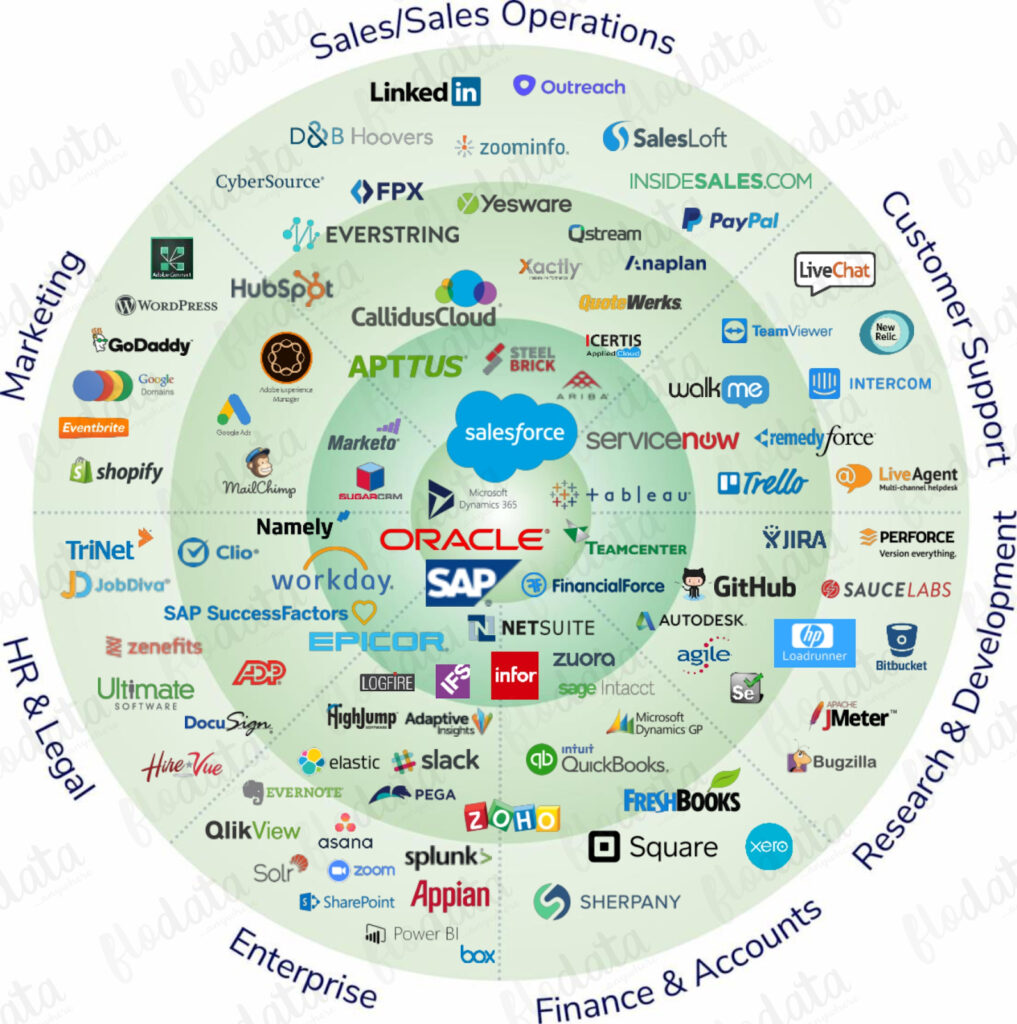
In today’s digital transformation era, no enterprise depends on or runs on a single application. They use a multitude of different IT systems to support the users and enable operational processes to achieve greater efficiency. This is why businesses with complex IT environments are making efforts to understand how systems can be integrated and the related activities necessary to manage integrations across the organizational ecosystem.

Current Enterprise Systems Landscape (sample)
Why do organizations need integration platforms?
In a digital economy where businesses interact with customers and stakeholders 24/7, the integration platform as a service (iPaaS) enables organizations to manage the integration needs. Post iPaaS implementation, customers derive higher ROI and enhanced business success.
The truth of the matter is, iPaaS will be widely leveraged by organizations in the coming years. It fits well and is an undeniably important component of business enablement. Reason? It allows stitching different systems together. Without it, no enterprise can complete initiatives comprising financial data, client data, IoT data, efficient service, quicker time-to-market, strengthened supply chain and so on. The list is practically endless.
Let’s understand its relevance better with a few examples –
- If the storage location of your customer data is different from where the invoicing data is stored, you need integration to stitch this data together.
- If there are mistakes in billing or customer records and you want to get rid of them, you need a master data management system that will allow you to integrate all the key business systems.
- If you want to integrate the backend applications with mobile systems and web services, you need an integration platform.
Most would agree that despite the system integration platform being a non-avoidable business asset, not many have been successful in maximizing its full potential. Reason? The essential part of its success relies on the type of enterprise data integration platform that you opt for.
Wondering how to ensure that you choose the most versatile solution that can meet all your organization’s business integration needs? Welcome to the world of FloData.
What is FloData?
It is a system integration as a service platform that enables seamless data and business process integration leveraging built-in connectors for the enterprise software applications, irrespective of their size and location, i.e., on the cloud or on-premise. Popular among the customers for its ability to allow quick integration, migration, and automation of data, FloData brings all of the applications, data, and devices, platforms together through a secure, high-performance network.
No matter what you call it – data automation, application integration, data integration, data migration – FloData’s integration platform is the most effective and comprehensive solution ever created that can automate all your internal and external business processes at scale without sacrificing quality, worrying about writing code or burning a hole in your pocket.
Why choose FloData?
Simply put, FloData helps organizations integrate/ migrate data between their enterprise platforms and systems. FloData Solution Accelerators help customers configure integrations and simplify data migrations rather than build them, resulting in reduced time to code, time to market and optimized total cost of ownership.
What are the benefits of FloData as a world-class integration platform?
FloData helps businesses deliver on their digital-first initiatives quickly and create a competitive edge with the mission-critical attributes mentioned below:
- Connect with any data source anywhere, on-premises, in-cloud or both.
- Integrate and migrate within a few days, not weeks or months.
- Boasts a distributed and scalable architecture.
- Build a hassle-free connection between apps and the data landscape.
- One platform to manage and track communications.
- An extensive library of 60+ plug-and-play connectors along with support for different integration patterns.
- No coding approach to maximize workforce productivity.
- Distributed security model and controlled deployment across network end-points.
- Reuses business logic and data flow recommendations to simplify the integration process.
- Best-in-class and scalable deployment model.
- No need to source and deploy technology in multiple environments.
- Spend more time on real work and less time switching between tools.
- In-built ability to track data reduces the risk of data breaches.
How does FloData work for businesses?
FloData’s sophisticated, easy to use interface works just the way it should be. Moreover, it simplifies and monitors the whole integration process. The integration process happens by completing the below-mentioned three steps:
- Define the source and target connections
- Map them to your requirements
- Define rules and schedule jobs
Final thoughts
FloData, a market-leading scalable, high-performance enterprise data integration platform, provides complete business enablement. From curtailing time and costs associated with manual processing to removing manual errors, bettering data quality, enhancing productivity and so on, FloData gives businesses the edge needed to stay competitive.
Ready to learn how FloData helps leading companies accelerate their business transformation efforts and why it is globally recognized as a leader in the iPaaS market? Talk to our experts now.



